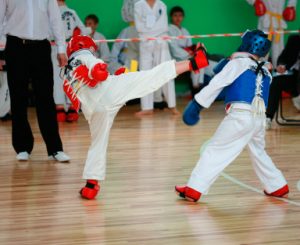Taekwon-Do is a martial art to be used only for self defence and only in the cause of justice. The history of Korea contains not a single sample of its military forces being employed for the invasion of its neighbors or for any other purpose except national defence.� – General Choi, Hong Hi.Taekwon-Do is a modern form of self defence originating from Korea, founded by Grand Master General Choi, Hong Hi (1918-2002). He developed Taekwon-Do by researching other martial arts and by using modern scientific principles to design techniques that have maximum power and effectiveness. Taekwon-Do has grown in popularity since its inception and is now taught in nearly every country in the world. It is most famous for its spectacular and dynamic kicking techniques, although this has led to the misconception that Taekwon-Do is just a kicking art. Taekwon-Do does indeed make extensive use of the legs, since the legs are longer and more powerful than the arms, but kicks make up only a small fraction of the total number of Taekwon-Do techniques. There are also blocks, punches and strikes with the hands or arms as well as basic throws and grappling. The wide range of techniques caters for all types of situations, and students are taught to defend against single and multiple opponents, on foot, seated and prone, and against weapons such as sticks and knives.
A pattern is a series of fundamental movements, both offensive and defensive, performed against an imaginary opponent. The patterns in Taekwon-Do are 24 distinct choreographed sets of movements that encompass most of Taekwon-Do’s many techniques. Patterns are the basic building blocks of the art. They teach the various stances and attacking and blocking techniques, but they also teach how to move and shift your weight distribution, develop technique, condition muscle and build strength, improve concentration and practise breath control. When done properly, they are extremely tiring.
Sparring is the application of Taekwon-Do techniques against an opponent in a more realistic but controlled environment.Sparring is conducted between pairs of students  of varying grade, using protective equipment to minimise injury. Adult sparring is semi-contact, meaning that techniques are used to score points rather than inflict damage, and children’s sparring is entirely non-contact. Sparring is an excellent way of developing speed, stamina and reflexes.
of varying grade, using protective equipment to minimise injury. Adult sparring is semi-contact, meaning that techniques are used to score points rather than inflict damage, and children’s sparring is entirely non-contact. Sparring is an excellent way of developing speed, stamina and reflexes.
Breaking, (also called destruction or power testing), is the breaking of anything from reusable plastic boards to wooden boards, roof tiles and concrete blocks. Taekwon-Do techniques, when applied correctly, can be devastating, so breaking is practised as a way of demonstrating techniques at full power in a way that does not risk injury to an opponent.Good technique, concentration and focus are more important than physical strength.
Special Technique is the kicking of a board, suspended high above the ground, using certain jumping kicking techniques. Taekwon-Do is a complete martial art, but it has a large complement of impressive kicking techniques.Special Technique showcases the more “flashy” of these kicks, involving jumping and/or spinning in mid air. These types of kicks really build leg strength and flexibility.
Self defence is the application of Taekwon-Do techniques specifically to defend against certain real-life situations.Students of Taekwon-Do are taught to be aware of their surroundings and to avoid confrontation wherever possible, but the situation may still arise where a student is attacked without reason or warning. Taekwon-Do’s Self Defence techniques deal specifically with this type of situation, teaching ways to release from a grab or hold in order to gain a position where a counter-attack, joint lock or throw can be applied, to allow the student enough time to move away from the situation safely.